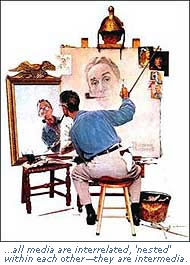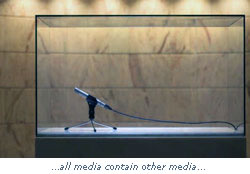Interlocked Circles of the Senses: A New Taxonomy of Media
Fig. 1, Fig. 2
After seeing the Chicago School of Media Theory's presentation of their Hypercube taxonomy model, I found it extremely difficult to perceive of any other way to effectively construct a remotely-comprehensive system of ordering media; I became more and more frustrated as each new scheme or diagram that I tried to design proved to be exceedingly inadequate. The most appealing element of the hypercube model is the opportunity it presents to get at least some idea of how multiple forms of media relate to each other, seeing that they can be collectively viewed in the multi-dimensional space of the hypercube.
 With this aspect in mind, I have constructed a visual diagram that strives to illustrate this very interdependency among and perhpas within various media that the hypercube was so effective in demonstrating. By, in effect, layering or intersecting the three circles (representative of different sensory categorizations of media), the overlap of the media and the criteria by which I judge them is literally made visible in a single representation. On a simple Excel graph, there are countless rows and columns of signs arranged in such a way that their interrelationships are only apparent after a considerable amount of review; likewise in the above diagram, all the data cannot be taken in at once. However, my proposed schematic proves to be more effective than a solitary chart, for it makes explicit the overlap, the necessary cross-referencing, involved in any discourse that involves media and the sensory faculties they engage to different degrees. Thus, the spatial mode of the model above embodies the ideas of two great media theorists—Marshall McLuhan and C.S. Peirce—that all media contain other media, and that media are not 'pure,' in the sense that they are only iconic, indexical or symbolic. As the interlocked circles show, and as the Rockewell painting reminds us, all media are interrelated, 'nested' within each other—they are intermedia.
With this aspect in mind, I have constructed a visual diagram that strives to illustrate this very interdependency among and perhpas within various media that the hypercube was so effective in demonstrating. By, in effect, layering or intersecting the three circles (representative of different sensory categorizations of media), the overlap of the media and the criteria by which I judge them is literally made visible in a single representation. On a simple Excel graph, there are countless rows and columns of signs arranged in such a way that their interrelationships are only apparent after a considerable amount of review; likewise in the above diagram, all the data cannot be taken in at once. However, my proposed schematic proves to be more effective than a solitary chart, for it makes explicit the overlap, the necessary cross-referencing, involved in any discourse that involves media and the sensory faculties they engage to different degrees. Thus, the spatial mode of the model above embodies the ideas of two great media theorists—Marshall McLuhan and C.S. Peirce—that all media contain other media, and that media are not 'pure,' in the sense that they are only iconic, indexical or symbolic. As the interlocked circles show, and as the Rockewell painting reminds us, all media are interrelated, 'nested' within each other—they are intermedia.
 The logic for using drawn images (an eye, an ear, a hand) as—to use Saussure's terminology—signifiers of actual human senses is manifold. In their most basic sense, each of the signs represents specific sensory receptors, thus underscoring McLuhan's claim that "all media are extensions of some human faculty, psychic or physical." The use of the images also illustrates the self-referencing of Peirces' 'Three Trichotomies of Signs'; the signs are iconic in that they resemble the actual sensory receptors (eye, ear, hand) of the human body; they are (primarily) indexical because they refer—by synecdoche (a part-whole relationship)—to the act of seeing/hearing/touching; and they are symbolic because it is conventionally understood/determinable that an eye stands for the act of looking/seeing, the ear for hearing, the hand for touching/feeling. Thus, the motivation behind the use of these simple illustrations ultimately communicates the fact that such categorizations as 'icon,' 'symbol,' and 'index,' can be used interdependently so as to fuse the pictorial and the conventional.
The logic for using drawn images (an eye, an ear, a hand) as—to use Saussure's terminology—signifiers of actual human senses is manifold. In their most basic sense, each of the signs represents specific sensory receptors, thus underscoring McLuhan's claim that "all media are extensions of some human faculty, psychic or physical." The use of the images also illustrates the self-referencing of Peirces' 'Three Trichotomies of Signs'; the signs are iconic in that they resemble the actual sensory receptors (eye, ear, hand) of the human body; they are (primarily) indexical because they refer—by synecdoche (a part-whole relationship)—to the act of seeing/hearing/touching; and they are symbolic because it is conventionally understood/determinable that an eye stands for the act of looking/seeing, the ear for hearing, the hand for touching/feeling. Thus, the motivation behind the use of these simple illustrations ultimately communicates the fact that such categorizations as 'icon,' 'symbol,' and 'index,' can be used interdependently so as to fuse the pictorial and the conventional.
[continue to Fig. 2]
Fig. 1, Fig. 2
After seeing the Chicago School of Media Theory's presentation of their Hypercube taxonomy model, I found it extremely difficult to perceive of any other way to effectively construct a remotely-comprehensive system of ordering media; I became more and more frustrated as each new scheme or diagram that I tried to design proved to be exceedingly inadequate. The most appealing element of the hypercube model is the opportunity it presents to get at least some idea of how multiple forms of media relate to each other, seeing that they can be collectively viewed in the multi-dimensional space of the hypercube.
 With this aspect in mind, I have constructed a visual diagram that strives to illustrate this very interdependency among and perhpas within various media that the hypercube was so effective in demonstrating. By, in effect, layering or intersecting the three circles (representative of different sensory categorizations of media), the overlap of the media and the criteria by which I judge them is literally made visible in a single representation. On a simple Excel graph, there are countless rows and columns of signs arranged in such a way that their interrelationships are only apparent after a considerable amount of review; likewise in the above diagram, all the data cannot be taken in at once. However, my proposed schematic proves to be more effective than a solitary chart, for it makes explicit the overlap, the necessary cross-referencing, involved in any discourse that involves media and the sensory faculties they engage to different degrees. Thus, the spatial mode of the model above embodies the ideas of two great media theorists—Marshall McLuhan and C.S. Peirce—that all media contain other media, and that media are not 'pure,' in the sense that they are only iconic, indexical or symbolic. As the interlocked circles show, and as the Rockewell painting reminds us, all media are interrelated, 'nested' within each other—they are intermedia.
With this aspect in mind, I have constructed a visual diagram that strives to illustrate this very interdependency among and perhpas within various media that the hypercube was so effective in demonstrating. By, in effect, layering or intersecting the three circles (representative of different sensory categorizations of media), the overlap of the media and the criteria by which I judge them is literally made visible in a single representation. On a simple Excel graph, there are countless rows and columns of signs arranged in such a way that their interrelationships are only apparent after a considerable amount of review; likewise in the above diagram, all the data cannot be taken in at once. However, my proposed schematic proves to be more effective than a solitary chart, for it makes explicit the overlap, the necessary cross-referencing, involved in any discourse that involves media and the sensory faculties they engage to different degrees. Thus, the spatial mode of the model above embodies the ideas of two great media theorists—Marshall McLuhan and C.S. Peirce—that all media contain other media, and that media are not 'pure,' in the sense that they are only iconic, indexical or symbolic. As the interlocked circles show, and as the Rockewell painting reminds us, all media are interrelated, 'nested' within each other—they are intermedia. The logic for using drawn images (an eye, an ear, a hand) as—to use Saussure's terminology—signifiers of actual human senses is manifold. In their most basic sense, each of the signs represents specific sensory receptors, thus underscoring McLuhan's claim that "all media are extensions of some human faculty, psychic or physical." The use of the images also illustrates the self-referencing of Peirces' 'Three Trichotomies of Signs'; the signs are iconic in that they resemble the actual sensory receptors (eye, ear, hand) of the human body; they are (primarily) indexical because they refer—by synecdoche (a part-whole relationship)—to the act of seeing/hearing/touching; and they are symbolic because it is conventionally understood/determinable that an eye stands for the act of looking/seeing, the ear for hearing, the hand for touching/feeling. Thus, the motivation behind the use of these simple illustrations ultimately communicates the fact that such categorizations as 'icon,' 'symbol,' and 'index,' can be used interdependently so as to fuse the pictorial and the conventional.
The logic for using drawn images (an eye, an ear, a hand) as—to use Saussure's terminology—signifiers of actual human senses is manifold. In their most basic sense, each of the signs represents specific sensory receptors, thus underscoring McLuhan's claim that "all media are extensions of some human faculty, psychic or physical." The use of the images also illustrates the self-referencing of Peirces' 'Three Trichotomies of Signs'; the signs are iconic in that they resemble the actual sensory receptors (eye, ear, hand) of the human body; they are (primarily) indexical because they refer—by synecdoche (a part-whole relationship)—to the act of seeing/hearing/touching; and they are symbolic because it is conventionally understood/determinable that an eye stands for the act of looking/seeing, the ear for hearing, the hand for touching/feeling. Thus, the motivation behind the use of these simple illustrations ultimately communicates the fact that such categorizations as 'icon,' 'symbol,' and 'index,' can be used interdependently so as to fuse the pictorial and the conventional.[continue to Fig. 2]